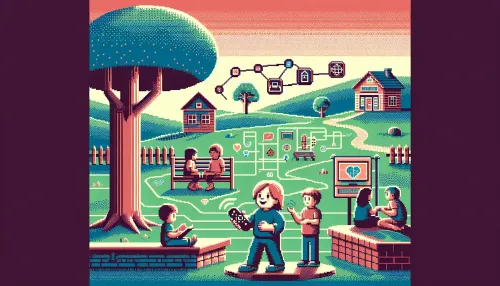Empathy Engines: Crafting Interactive Narratives to Foster Understanding Among Autistic Peers

In recent years, the landscape of supporting autistic children has seen a transformative shift, driven by the intersection of technology, empathy, and education. One prominent development that has emerged as a game-changer is the integration of interactive digital platforms to facilitate connection and understanding between autistic children and their neurotypical peers. This innovative approach not only holds great promise for enhancing social integration but also embodies a pioneering stride towards building a more inclusive society.
Transformative Shift in Supporting Autistic Children
In this digital age, storytelling has transcended traditional boundaries, evolving into an immersive experience that holds the potential to bridge the gap between autistic children and their peers. Interactive digital platforms, such as storytelling apps and virtual reality narratives, are reshaping how empathy is cultivated and understood.
Interactive Digital Platforms: Bridging Connections
Research has demonstrated that interactive narratives tailored to resonate with autistic experiences and emotions can serve as powerful tools for fostering connection and understanding among peers. These platforms not only enable autistic children to express themselves in a safe and engaging environment but also provide an avenue for their neurotypical counterparts to gain valuable insights into the autistic perspective.
The impact of virtual empathy exercises extends far beyond the digital realm, influencing real-world interactions and social integration. Through immersive experiences facilitated by digital platforms, autistic children are presented with scenarios that mimic interpersonal dynamics, emotional cues, and social contexts, empowering them with practical skills that transcend the virtual space.
Real-World Impact of Virtual Empathy Exercises
Moreover, these virtual empathy exercises have shown promising results in enhancing communication and collaboration among peers. By enabling neurotypical individuals to step into the world of an autistic person through digital simulations, these exercises promote empathy, diminish social barriers, and lay a solid foundation for meaningful connections.
Narrative gaming serves as a compelling medium to teach emotional and social cues to autistic children in an engaging and interactive manner. By gamifying learning experiences, narrative games provide a unique avenue for autistic individuals to decode complex social situations and emotional nuances within a controlled and supportive environment.
These narrative games are intricately designed to align with the emotional and cognitive needs of autistic children, catering to their sensory preferences while reinforcing crucial social and emotional skills. The fusion of storytelling with gamification not only captivates the attention of autistic individuals but also equips them with valuable tools for navigating real-life social scenarios with confidence.
Narrative Gaming for Emotional and Social Skills
The seamless fusion of technological advancements with empathetic narratives rests upon a robust technical backbone that drives the creation and delivery of these transformative experiences. Artificial intelligence, machine learning algorithms, and interactive user interfaces form the core components empowering empathetic narratives to adapt and respond dynamically to the user's emotional expressions and feedback.
Moreover, the integration of haptic feedback mechanisms further enhances the immersive nature of these digital platforms by providing tactile stimuli that complement visual and auditory experiences. This intricate blend of technology not only amplifies user engagement but also paves the way for personalized narratives that cater to the unique needs of every individual.
The Technology Behind Empathetic Narratives
Empathy-driven narratives extend beyond empowering autistic children; they also play a pivotal role in cultivating heightened awareness among neurotypical peers. By immersing themselves in simulated environments that mirror autistic experiences, neurotypical individuals gain profound insights into the sensory sensitivities, emotional responses, and communication challenges faced by their autistic counterparts.
These immersive experiences foster empathy, dismantle misconceptions, and cultivate a culture of inclusivity among neurotypical peers. As a result, they not only pave the way for meaningful connections but also nurture an environment where differences are embraced and celebrated.
Creating Immersive Experiences for Neurotypical Peers
Augmented reality (AR) narratives offer a groundbreaking avenue for supporting emotional intelligence development among autistic children. By overlaying digital elements onto the real world, AR narratives create an experiential platform for individuals to explore and comprehend varied emotional states, social nuances, and non-verbal communication cues in real-time interactions.
Through personalized AR narratives tailored to individual developmental stages and emotional needs, autistic children can enhance their emotional literacy while navigating day-to-day social encounters with increased confidence. This innovative approach not only empowers them with essential life skills but also enriches their social experiences through heightened self-awareness.
The evolution of interactive empathy platforms encompasses a multidisciplinary journey marked by continuous innovation and collaboration across fields such as psychology, education, technology, and user experience design. The inception stage involves meticulous research to understand the nuanced needs of autistic individuals along with extensive consultations with educators, psychologists, and individuals within the autism community.
Related Article: The Intersection of Tradition and Technology: Innovative Approaches in Culturally Diverse Autism Support
Augmented Reality for Emotional Intelligence Development
As ideas materialize into tangible concepts, iterative testing and refinement form an integral part of the development process. User feedback channels serve as invaluable resources for steering the trajectory of these platforms towards maximum effectiveness while ensuring seamless integration with educational curriculums and therapeutic settings.
The hallmark of impactful empathy-building tools lies in their user-centric design approach which prioritizes inclusivity by involving autistic users in every phase of development. Collaborative co-design sessions offer a platform for autistic individuals to share their insights regarding their sensory sensitivities, communication preferences, and emotional responses – thereby shaping empathetic narratives that resonate authentically with their experiences.
The Development Path of Interactive Empathy Platforms
Furthermore, ongoing user involvement post-launch facilitates continuous improvement based on real-world usage patterns and evolving user requirements. This iterative approach not only ensures that the platforms remain aligned with the diverse needs of autistic individuals but also underscores a commitment to fostering genuine understanding through co-creation.
In conclusion, the fusion of technology with empathy has opened unprecedented avenues for fostering understanding among autistic children and nurturing inclusive environments where differences are celebrated. As we peer into the future horizons of supporting neurodiverse communities, interactive empathy platforms stand as resilient pillars championing empathy as a transformative force that transcends boundaries – paving the way for a more empathetic world where every individual's story is heard and understood.
Frequently Asked Questions
Empathy engines are interactive digital platforms designed to foster understanding between autistic children and their neurotypical peers. They utilize storytelling and immersive experiences to enhance social integration, enabling both groups to connect through shared narratives and emotional insights.
Interactive digital platforms provide a safe and engaging environment for autistic children to express their thoughts and emotions. By using storytelling apps and virtual reality, these platforms allow for creative self-expression while helping neurotypical peers understand the autistic perspective.
Virtual empathy exercises significantly enhance social integration by allowing autistic children to practice interpersonal dynamics in realistic scenarios. These exercises promote communication skills and collaboration among peers, breaking down social barriers and fostering meaningful connections.
Narrative gaming engages autistic children in learning about emotional and social cues through gamified experiences. These games are tailored to their needs, helping them decode complex social situations while reinforcing essential skills in a supportive environment.
The creation of empathetic narratives relies on advanced technologies like artificial intelligence, machine learning, and interactive user interfaces. These technologies enable personalized experiences that adapt to users' emotional expressions, enhancing engagement and understanding.
Immersive experiences allow neurotypical peers to step into the shoes of autistic individuals, fostering empathy and understanding. By simulating sensory sensitivities and communication challenges, these experiences help dismantle misconceptions and promote inclusivity.
Augmented reality (AR) enhances emotional intelligence development by overlaying digital elements onto real-world interactions. This approach helps autistic children explore emotional states and social nuances in real-time, improving their emotional literacy and confidence in social situations.
The development of interactive empathy platforms involves multidisciplinary collaboration across psychology, education, technology, and design. Extensive research and user feedback guide the iterative process, ensuring that the platforms meet the unique needs of autistic individuals effectively.
User-centric design is crucial because it involves autistic individuals in every stage of tool development. This approach ensures that the tools resonate authentically with their experiences, leading to more effective empathy-building narratives that cater to diverse needs.
Interactive empathy platforms have the potential to transform how society understands neurodiversity. By fostering genuine connections between autistic individuals and their peers, these platforms can create inclusive environments where differences are celebrated, paving the way for a more empathetic world.
Check Out These Related Articles

Cultural Resonance and Inclusion: Redefining Autistic Identities and Perspectives Globally

Breaking Barriers: Out-of-the-Box Approaches to Addressing Social Challenges Faced by Autistic Children

Building Bridges: How Global Sports Programs Empower Autistic Children
